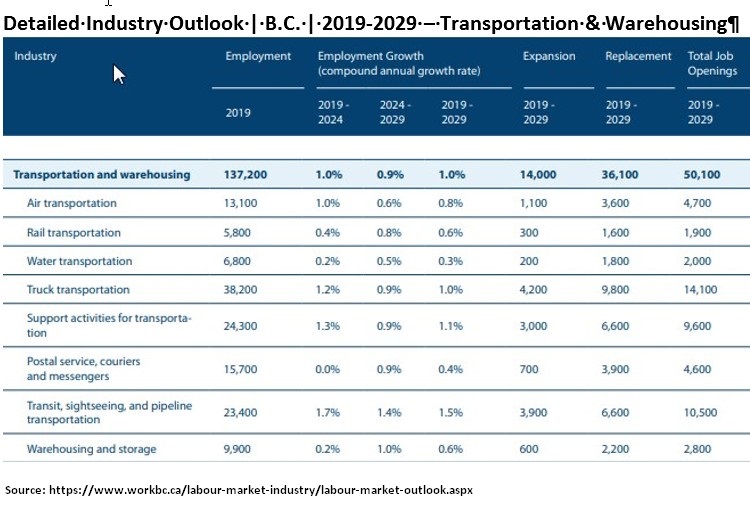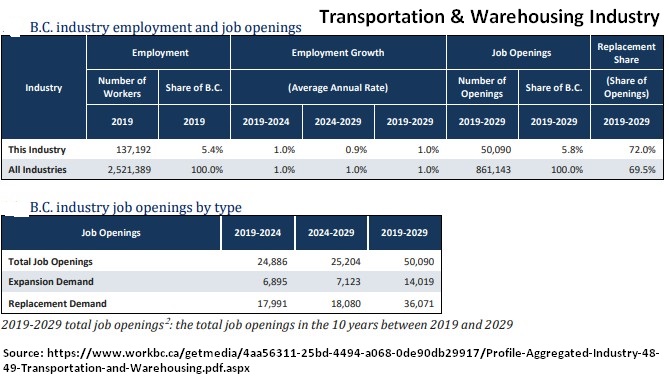Overview of the Transportation Industry

BC’s Transportation & Warehousing Industry
For the period 2018-2019, employment in BC’s transportation & warehousing industry grew at 3.5% with job growth of 4800 for a total of 140,600 employed in B.C.



Across Canada, in 2019, 972,600 employees (including self-employed people) worked in the transportation and warehousing sector, up 5.7% from 2018. Employment in the transportation and warehousing sector accounts for about 5% of total employment, a share that has stayed stable over the past two decades.
The Transportation and Warehousing industry in Canada is expected to expand its workforce at a faster than average pace over the next ten years up to 2029. The industry is projected to have 50,100 job openings over the 2019- 2029 period. Over 72 percent of those job openings are a result of the need to replace workers leaving the labour force.
Trucking & Logistics Industry
Across Canada, the Trucking & Logistics industry includes 300,000 truck drivers (46% of the industry workforce), 90,000 people in shipping and receiving, 70,000 courier service drivers, 38,000 material handlers at warehouses and distribution centers, and: an estimated 40,000 managers, supervisors, and administrative staff, along with 9,000 accounting personnel.
Based on the current economic and demographic projections, overall labour demand for occupations in the trucking and logistics sector is forecast to increase at an average annual pace of 0.9% over the next three to five years (to 2023).
Truck Drivers Employment Vacancies in Canada
The total number of truck driver vacancies in Canada has increased over 138% between 2016 and 2019 – climbing from 8,600 to 20,500 – an average job vacancy rate of 6.8%.
During the period 2019-2023 27,000 truck drivers will leave the occupation voluntarily or involuntarily on an annual basis and an additional 7,200 truck drivers will retire. By 2023, we expect truck driver vacancies will have surpassed 25,000 unfilled positions, an increase of over 25% compared with 2019. Demographic projections suggest that the growth of younger workers, particularly those with less than high school or high school education alone, will not be sufficient to offset the anticipated exits stemming from retirement* and other attrition.
*According to the Statistic Canada’s 2016 Census, 32% of truck drivers in Canada were 55 years or older, compared to 21% of the entire Canadian labour force.
Potential sources of new drivers into the occupation include new entries into the occupation (recently having left formal education), entries from other occupations, recent immigrants, and non-permanent residents (either temporary foreign workers or those here on working visas).
Immigrants Entry to Transportation Industry
Immigrants are seen as a key source of talent as transportation companies seek to meet their hiring needs in the years ahead.
The industry has responded by developing a number of programs to attract newcomers. These include:
- initiatives to attract newcomers to remote locations of the province
- corporate efforts to encourage diversity in the workplace
- strategies for streamlining foreign-credential recognition
One initiative is SkilledTradesBC Certification Information for Newcomers and International Tradespersons, which helps skilled immigrants who are unemployed, or employed and low-skilled, overcome barriers to entering the trades, including jobs in aviation and aerospace.
More information:
The BC Trucking Association(BCTA) has developed a tool to assist employers when hiring newcomers to Canada. This guide helps employers compare your professional driving experience in your home country to Canadian driving standards.
More information:
For more information on the transportation sector see:
